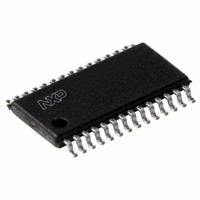P89LPC932A1FDH,512 NXP Semiconductors, P89LPC932A1FDH,512 Datasheet - Page 24

P89LPC932A1FDH,512
Manufacturer Part Number
P89LPC932A1FDH,512
Description
IC 80C51 MCU FLASH 8K 28-TSSOP
Manufacturer
NXP Semiconductors
Series
LPC900r
Datasheet
1.P89LPC932A1FDH529.pdf
(64 pages)
Specifications of P89LPC932A1FDH,512
Program Memory Type
FLASH
Program Memory Size
8KB (8K x 8)
Package / Case
28-TSSOP
Core Processor
8051
Core Size
8-Bit
Speed
18MHz
Connectivity
I²C, SPI, UART/USART
Peripherals
Brown-out Detect/Reset, LED, POR, PWM, WDT
Number Of I /o
26
Ram Size
768 x 8
Voltage - Supply (vcc/vdd)
2.4 V ~ 3.6 V
Oscillator Type
Internal
Operating Temperature
-40°C ~ 85°C
Processor Series
P89LPC9x
Core
80C51
Data Bus Width
8 bit
Data Ram Size
768 B
Interface Type
I2C/SPI/UART
Maximum Clock Frequency
18 MHz
Number Of Programmable I/os
26
Number Of Timers
2
Operating Supply Voltage
2.4 V to 3.6 V
Maximum Operating Temperature
+ 85 C
Mounting Style
SMD/SMT
3rd Party Development Tools
PK51, CA51, A51, ULINK2
Minimum Operating Temperature
- 40 C
Cpu Family
89LP
Device Core
80C51
Device Core Size
8b
Frequency (max)
18MHz
Total Internal Ram Size
768Byte
# I/os (max)
26
Number Of Timers - General Purpose
2
Operating Supply Voltage (typ)
2.5/3.3V
Operating Supply Voltage (max)
3.6V
Operating Supply Voltage (min)
2.4V
Instruction Set Architecture
CISC
Operating Temp Range
-40C to 85C
Operating Temperature Classification
Industrial
Mounting
Surface Mount
Pin Count
28
Package Type
TSSOP
Lead Free Status / RoHS Status
Lead free / RoHS Compliant
For Use With
OM6292 - DEMO BOARD PCA2125 RTCDB-TSSOP-LPC932 - BOARD FOR LPC932 TSSOP622-1014 - BOARD FOR LPC9XX TSSOP622-1008 - BOARD FOR LPC9103 10-HVSON622-1006 - SOCKET ADAPTER BOARDMCB900K - BOARD PROTOTYPE NXP 89LPC9EPM900K - EMULATOR/PROGRAMMER NXP P89LPC9568-4000 - DEMO BOARD SPI/I2C TO DUAL UART568-3510 - DEMO BOARD SPI/I2C TO UART622-1003 - KIT FOR LCD DEMO622-1002 - USB IN-CIRCUIT PROG LPC9XX568-1759 - EMULATOR DEBUGGER/PROGRMMR LPC9X568-1758 - BOARD EVAL FOR LPC93X MCU FAMILY
Eeprom Size
-
Data Converters
-
Lead Free Status / Rohs Status
Lead free / RoHS Compliant
Other names
568-4515-5
935276132512
P89LPC932A1FDH
P89LPC932A1FDH
935276132512
P89LPC932A1FDH
P89LPC932A1FDH
NXP Semiconductors
P89LPC932A1_3
Product data sheet
7.14.2 Power-on detection
7.15.1 Idle mode
7.15.2 Power-down mode
7.15.3 Total Power-down mode
7.15 Power reduction modes
7.16 Reset
For correct activation of brownout detect, the V
Please see
The Power-on detect has a function similar to the brownout detect, but is designed to work
as power comes up initially, before the power supply voltage reaches a level where
brownout detect can work. The POF flag in the RSTSRC register is set to indicate an
initial power-up condition. The POF flag will remain set until cleared by software.
The P89LPC932A1 supports three different power reduction modes. These modes are
Idle mode, Power-down mode, and Total Power-down mode.
Idle mode leaves peripherals running in order to allow them to activate the processor
when an interrupt is generated. Any enabled interrupt source or reset may terminate Idle
mode.
The Power-down mode stops the oscillator in order to minimize power consumption. The
P89LPC932A1 exits Power-down mode via any reset, or certain interrupts. In Power-down
mode, the power supply voltage may be reduced to the data retention voltage V
retains the RAM contents at the point where Power-down mode was entered. SFR
contents are not guaranteed after V
recommended to wake up the processor via reset in this case. V
within the operating range before the Power-down mode is exited.
Some chip functions continue to operate and draw power during Power-down mode,
increasing the total power used during power-down. These include: Brownout detect,
watchdog timer, Comparators (note that Comparators can be powered-down separately),
and RTC/System Timer. The internal RC oscillator is disabled unless both the RC
oscillator has been selected as the system clock and the RTC is enabled.
This is the same as Power-down mode except that the brownout detection circuitry and
the voltage comparators are also disabled to conserve additional power. The internal RC
oscillator is disabled unless both the RC oscillator has been selected as the system clock
and the RTC is enabled. If the internal RC oscillator is used to clock the RTC during
power-down, there will be high power consumption. Please use an external low frequency
clock to achieve low power with the RTC running during power-down.
The P1.5/RST pin can function as either an active-LOW reset input or as a digital input,
P1.5. The RPE (Reset Pin Enable) bit in UCFG1, when set to logic 1, enables the external
reset input function on P1.5. When cleared, P1.5 may be used as an input pin.
Remark: During a power-up sequence, The RPE selection is overridden and this pin will
always functions as a reset input. An external circuit connected to this pin should not
hold this pin LOW during a power-on sequence as this will keep the device in reset.
Table 8 “Static characteristics”
Rev. 03 — 12 March 2007
8-bit microcontroller with accelerated two-clock 80C51 core
DD
has been lowered to V
for specifications.
DD
rise and fall times must be observed.
P89LPC932A1
DDR
DD
, therefore it is highly
must be raised to
© NXP B.V. 2007. All rights reserved.
DDR
24 of 64
. This














